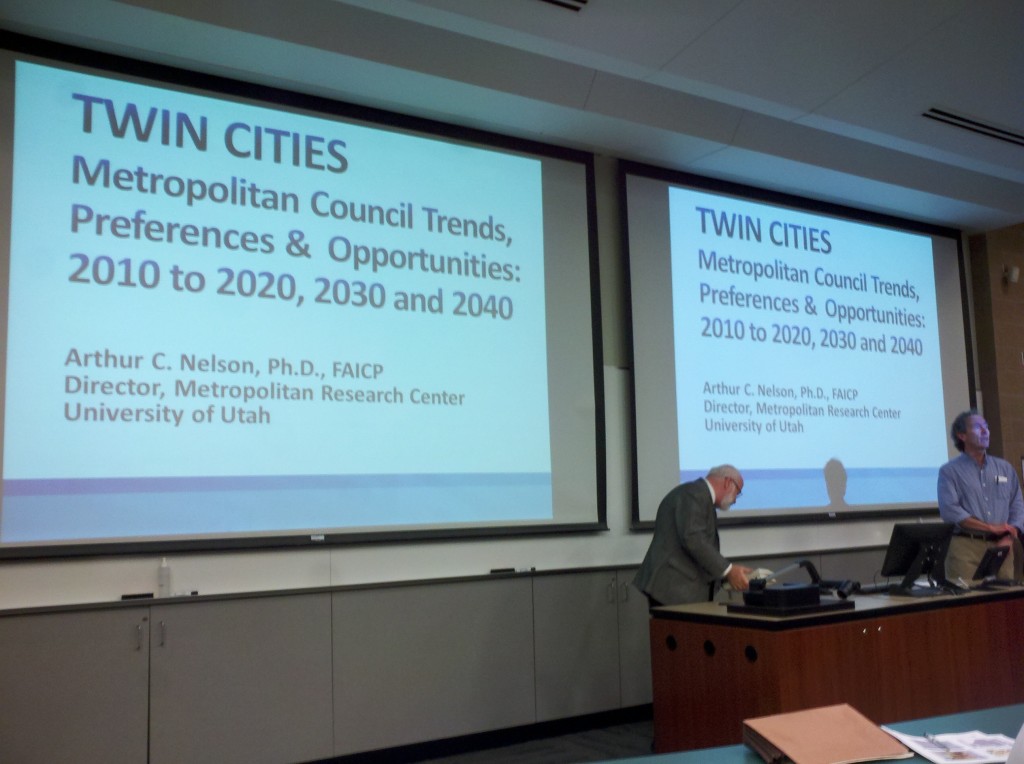
According to Nelson, the U.S. is reorganizing itself around so-called “economic engines,” which are the main regions that dictate national economic development activity. These large urban areas – known as “megapolitans” – represent about 200 million people, or about two-thirds of America’s population, and will account for 90-95% of the country’s growth by 2050.
Our local megapolitan, the Twin Cities metro area, consists of seven counties: Anoka, Hennepin, Ramsey, Washington, Carver, Scott and Dakota. Within Hennepin County alone, there are one million people and counting. Hennepin County, along with Ramsey County and the cities of Minneapolis and St. Paul (what Nelson refers to as the “Central Counties”), currently compose one-third of Minnesota’s total population and this share will only increase with time.
These numbers reflect the changes that are happening across the country, brought about by increasing numbers of immigrants, aging Baby Boomers and millennials who are seeking to move to cities for better access to amenities, such as transportation, and more lifestyle opportunities.
New Majority Growth
The “New Majority” consists of all persons besides non-Latino whites, mainly immigrants and children of immigrants. Until recently, non-Latino whites have always made up the majority of the U.S. population. But with the immigrant population exponentially growing, by 2040 the seemingly paradoxical “Majority-Minority” demographic will account for 91% of population growth nationwide and 100% of the change in the Twin Cities, according to Nelson. While he didn’t go particularly in-depth with the implications of these numbers, it is true that the “New Majority” will become the socio-, political and cultural drivers of the country. Consequently, their needs will determine a great deal of future housing preferences and trends.
Kristina Kelly, RNR’s Operations and Marketing Coordinator, questioned Nelson about this change and its relation to the future of homeownership.
“I wanted to find out how the racial and ethnic disparities between the current majority and the soon-to-be ‘Majority-Minority’ will have an impact on homeownership in the future,” said Kelly. “As a real estate company, it’s important to know how these changes will affect our market.”
In response to Kelly’s question, Nelson said that this gap is mainly due to a lack of education, and that he doesn’t see there being a significant amount of growth in the future of American education to close those gaps. Nene Matey-Keke, the broker/owner of RNR and a proponent of helping members of diverse communities become homeowners, does his part to lessen the educational breach by teaching bi-monthly Home Stretch classes for first time homebuyers.
Baby Boomers
Baby Boomers (those born between 1946 and 1964) and current senior citizens will account for a whopping 95% of the household change in the Central Counties between 2010 and 2040. This change is due mostly to the fact that people within this age group are becoming empty-nesters and are losing spouses from old age and other age-related illnesses. Decreases in household size for these people leads to downsizing and moving to assisted living facilities, subsequently increasing the number of homes for sale. For example, when the first of the Baby Boomers hit 70 years old in 2016, they will start to try selling their homes in large numbers (and this trend will continue through about 2034). However, because of changing demands for households (such as an increase in households without children and people living alone), there just won’t be enough demand for the drastic increase in supply. In fact, according to Nelson, there will be an excess of about 70,000 sellers in the Twin Cities metro region alone. He suggests that policymakers need to come up with a solution to fix planning and zoning policy to soften the blow.
Household Type
Research has shown that consumers are at their peak homebuying age between 35-64 years old. However, Nelson’s study shows that this demographic will account for a mere 1% of household growth in the Twin Cities by 2040, whereas those 65 years and older will total 95% of that share. Because of high unemployment rates and low wages overall, people that will be 35-64 years old at that time simply won’t have enough money to purchase houses, much less the McMansions and suburban dream homes that have been popular for the past few decades. According to Nelson, about 70-80% of current homebuyers want single-family detached homes. However, in the future, that will no longer be the case. People will desire – and only be able to afford – homes that are much smaller, including condos and apartments, but that are closer to megapolitan centers.
Erin Reyes, the marketing and communications intern at RNR, agrees. “As a millennial, I can attest to this fact. With increasing amounts of student loan debt and a competitive job market that’s keeping much of my generation un- or underemployed, for most of us, owning a home in the suburbs no longer seems feasible – or desirable. We want to be close to jobs located in the cities, which usually means choosing condos or apartments that aren’t necessarily spacious, but offer us easy access to work, transportation and other lifestyle opportunities.”
Shrinking household sizes also play into the changing housing market. Currently, about one-third of American households have children, but by 2040 households without children will grow by 81%, and the Twin Cities number is very similar (79%). Nelson suggests that developers and builders pay close attention to all of these evolving needs of buyers and adjust their business plans accordingly.
Nelson’s report and presentation slides are now available online.













